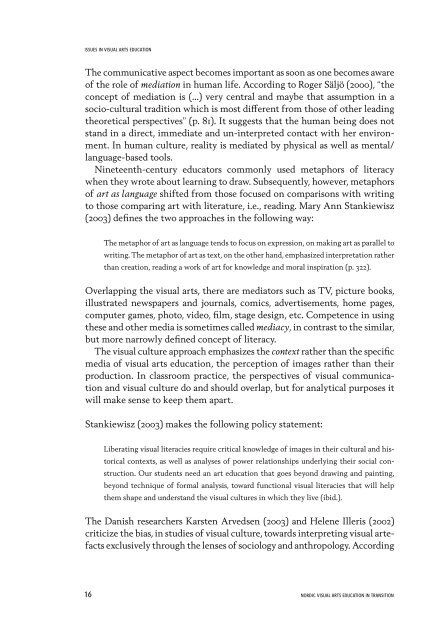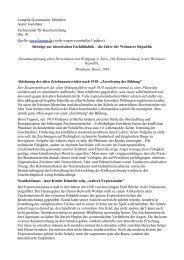Research in Visual Arts Education - The National Society for ...
Research in Visual Arts Education - The National Society for ...
Research in Visual Arts Education - The National Society for ...
You also want an ePaper? Increase the reach of your titles
YUMPU automatically turns print PDFs into web optimized ePapers that Google loves.
ISSUES IN VISUAL ARTS EDUCATION<br />
<strong>The</strong> communicative aspect becomes important as soon as one becomes aware<br />
of the role of mediation <strong>in</strong> human life. Accord<strong>in</strong>g to Roger Säljö (2000), “the<br />
concept of mediation is (…) very central and maybe that assumption <strong>in</strong> a<br />
socio-cultural tradition which is most different from those of other lead<strong>in</strong>g<br />
theoretical perspectives” (p. 81). It suggests that the human be<strong>in</strong>g does not<br />
stand <strong>in</strong> a direct, immediate and un-<strong>in</strong>terpreted contact with her environment.<br />
In human culture, reality is mediated by physical as well as mental/<br />
language-based tools.<br />
N<strong>in</strong>eteenth-century educators commonly used metaphors of literacy<br />
when they wrote about learn<strong>in</strong>g to draw. Subsequently, however, metaphors<br />
of art as language shifted from those focused on comparisons with writ<strong>in</strong>g<br />
to those compar<strong>in</strong>g art with literature, i.e., read<strong>in</strong>g. Mary Ann Stankiewisz<br />
(2003) def<strong>in</strong>es the two approaches <strong>in</strong> the follow<strong>in</strong>g way:<br />
<strong>The</strong> metaphor of art as language tends to focus on expression, on mak<strong>in</strong>g art as parallel to<br />
writ<strong>in</strong>g. <strong>The</strong> metaphor of art as text, on the other hand, emphasized <strong>in</strong>terpretation rather<br />
than creation, read<strong>in</strong>g a work of art <strong>for</strong> knowledge and moral <strong>in</strong>spiration (p. 322).<br />
Overlapp<strong>in</strong>g the visual arts, there are mediators such as TV, picture books,<br />
illustrated newspapers and journals, comics, advertisements, home pages,<br />
computer games, photo, video, film, stage design, etc. Competence <strong>in</strong> us<strong>in</strong>g<br />
these and other media is sometimes called mediacy, <strong>in</strong> contrast to the similar,<br />
but more narrowly def<strong>in</strong>ed concept of literacy.<br />
<strong>The</strong> visual culture approach emphasizes the context rather than the specific<br />
media of visual arts education, the perception of images rather than their<br />
production. In classroom practice, the perspectives of visual communication<br />
and visual culture do and should overlap, but <strong>for</strong> analytical purposes it<br />
will make sense to keep them apart.<br />
Stankiewisz (2003) makes the follow<strong>in</strong>g policy statement:<br />
Liberat<strong>in</strong>g visual literacies require critical knowledge of images <strong>in</strong> their cultural and historical<br />
contexts, as well as analyses of power relationships underly<strong>in</strong>g their social construction.<br />
Our students need an art education that goes beyond draw<strong>in</strong>g and pa<strong>in</strong>t<strong>in</strong>g,<br />
beyond technique of <strong>for</strong>mal analysis, toward functional visual literacies that will help<br />
them shape and understand the visual cultures <strong>in</strong> which they live (ibid.).<br />
<strong>The</strong> Danish researchers Karsten Arvedsen (2003) and Helene Illeris (2002)<br />
criticize the bias, <strong>in</strong> studies of visual culture, towards <strong>in</strong>terpret<strong>in</strong>g visual artefacts<br />
exclusively through the lenses of sociology and anthropology. Accord<strong>in</strong>g<br />
16 NORDIC VISUAL ARTS EDUCATION IN TRANSITION



